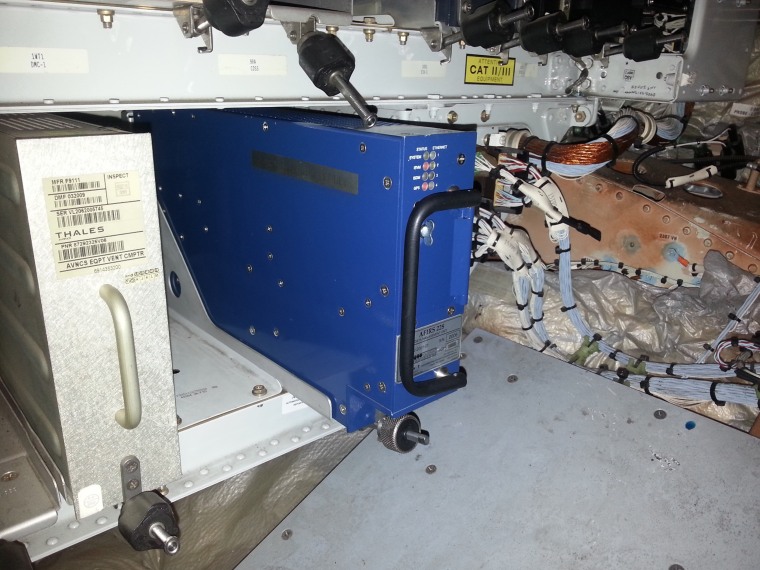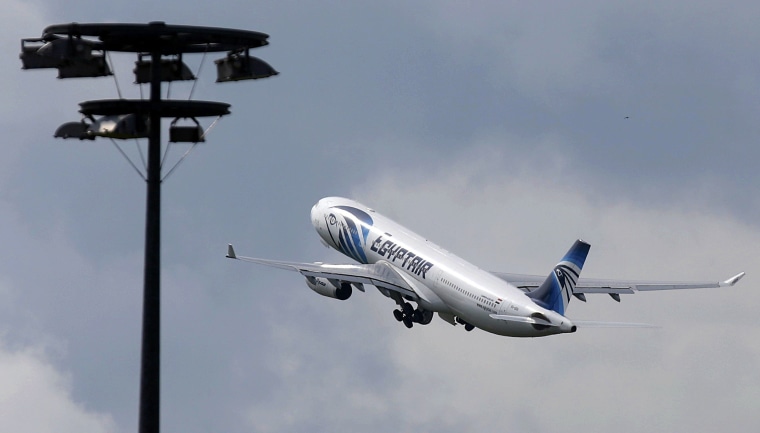In their quest to uncover what caused an EgyptAir jetliner's fatal plunge into the Mediterranean Sea this month, searchers are conducting a costly, time-consuming hunt for the jet's black box data recorders.
But in an age where digital data can be easily transmitted and stored remotely, the use of black boxes to record critical flight data increasingly strikes many experts as antiquated. In fact, the technology already exists to stream the aircraft's information to a ground computer or virtual "cloud" — it just hasn't been widely adopted.
Why are airlines balking? The biggest barrier, industry observers say, is cost.
FLYHT Aerospace Solutions in Canada provides an on-demand black box streaming service at about $100,000 per plane, including hardware and installation. The company says it has over 50 customers and is already installed in about 400 planes. Canada's First Air is the only airline to say publicly it is using the FLYHT system.
The system doesn't continuously send data to ground-based computers. Instead, it activates in the event of an abnormal occurrence, then quickly sends a torrent of data to the airline for analysis and to apply corrective action.
"In the event something goes wrong, we can provide quicker insight into what happened," said Graham Ingham, a former Skyservice Airlines manager who now works for FLYHT. "We can start piecing the puzzle together quicker, so (the airline) can lay to rest some of the conspiracies that are out there."

The streaming devices are similar to the black box hardware that has been used in aircraft for decades. Those devices consist of a cockpit voice recorder and a flight data recorder — each of which can provide indispensable information, including ambient noises and the flight's airspeed, altitude and direction, in the event of an accident.
FLYHT's program — dubbed the Automated Flight Information Reporting System — essentially duplicates the information that's typically found in the flight data recorder.
Many more commercial airliners are equipped with a technology called Aircraft Communications Addressing and Reporting System, which provides some data — though less than FLYHT's system — to the ground in real time.
During an emergency, FLYHT's system will automatically send back crucial flight-related data as well as provide the plane's position in real time — particularly helpful if the flight is on a transoceanic journey where flight control systems can lose track of it.
If a plane does crash, the data can help searchers pinpoint a more specific search location, Ingham said.
Related: Why Search for EgyptAir is Reminiscent of MH370 Hunt
It also could help investigators determine whether a catastrophic event such as an explosion occurred, he said, as the data received would likely show a loss of cabin pressure. The plane would continue to send data just as long as the aircraft still had power, he added.
Ingham stressed that streaming copious amounts of data to ground-based computers does not make the technology cost-prohibitive. Airlines must also pay a "few dollars" per minute to access the data, but that would amount to a "minimal" cost, he said, because an emergency doesn't typically last long.
And he doesn't believe the airlines would need to pass the costs on to consumers.
"It is not very often that an aircraft is in a position that would require it to live stream the black box," Ingham said. "Airline travel is very safe these days and continues to get better."
It isn't known how many planes are equipped with streaming technology to provide black box quality data to computers on the ground, but it's believed to be a small fraction of the commercial aircraft fleet, observers say. Qatar Airways announced last year it would introduce the technology into its fleet via the British satellite telecom company Inmarsat.
Other airlines are having to weigh whether the technology makes sense because crashes are so rare and have fallen to their lowest levels in recent years.
In 2015, there was one crash for every 3.1 million flights worldwide — the safest year on record, according to the International Air Transport Association.
Airlines for America, the trade group for the nation's air carriers, declined to comment on the need for live streaming of the data since there is no formal proposal in front of the FAA to require it.
Patrick Smith, an airline pilot and author of "Cockpit Confidential," said real-time tracking of commercial jets is useful, but real-time streaming of data is "fraught with complications."
"It'd be ... not especially useful except in those very rare instances when the black box recorders can't be found," he said in an email. "You have about 16 million commercial flights operating each year, virtually none of which disappear. Is this really the best way to spend our air safety dollars?"
Related: Terrorism Can't Be Ruled Out, Foreign Minister Says
Smith said there are also questions about who would maintain the streamed data and where it would be kept. (In the case of FLYHT, the data is sent to a secure server and belongs to the airline, Ingham said.)
Jim Hall, who served as the National Transportation Safety Board chairman from 1994 to 2001, said black boxes still have a purpose because they can be retrieved by independent investigators without the worry they would be tampered with or altered.
"If there’s that much information being streamed, who gets it?" Hall asked. "If it's a black box, it's supposed to be in the hands of the investigators."
In addition to streaming, Hall has suggested getting cameras inside cockpits, which pilot unions have opposed, and using ejectible recorders that would float, making it easier to find and recover them in the event of a crash at sea.
"The biggest problem with the black box now is that they can sink with the plane to the bottom of the ocean," Hall said. "So it can take weeks and millions of dollars to find it."
Investigators are still looking for the fuselage and black boxes of EgyptAir Flight 804 after it crashed May 19 with 66 people on board.
Nor have searchers found the fuselage or black boxes of Malaysia Airlines Flight MH370 since it went missing in March 2014. The cost of the search operation for the plane in a remote section of the Indian Ocean is reportedly at $130 million, making it the most-expensive search in aviation history.
The Air Line Pilots Association, International, the world's largest pilot union, told NBC News that the two accidents "underscore the importance of equipping all aircraft with tracking technology that can pinpoint location in near real time."
Spurred by the MH370 mystery, more planes are due to get such technology after the U.N.'s aviation agency in March approved a proposal for all newly designed aircraft to carry tracking devices that can transmit their location at least once a minute in an emergency. That won't go into effect until 2021.
The recent uptick in instances of missing planes and black boxes could force airlines to re-examine live data streaming sooner than later, said aviation analyst Richard Aboulafia.
"It'll happen," he said. "The technology change is outpacing regulatory change."

